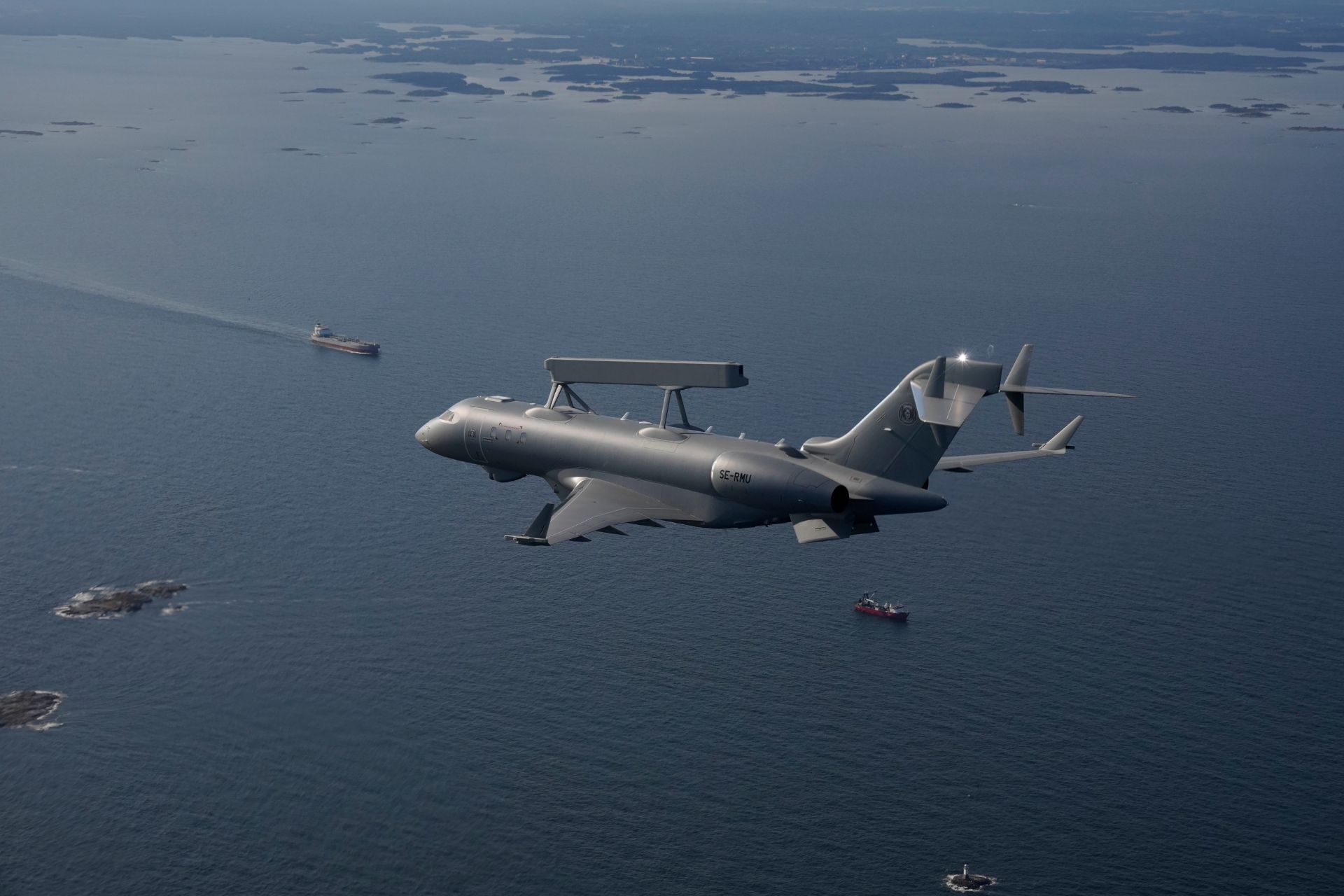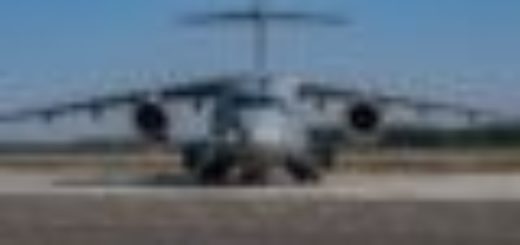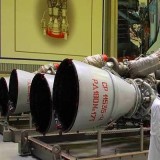Nordic Cooperation Advances for GlobalEye Surveillance Aircraft to Strengthen Baltic Sea Security

{loadposition bannertop}
{loadposition sidebarpub}
Discussions between Sweden, Finland, and Denmark on acquiring a joint intelligence capability are advancing significantly, particularly during the National Security Conference in Sälen on January 12, 2025. At the center of this dialogue is the GlobalEye reconnaissance aircraft, a cutting-edge platform developed by Swedish manufacturer Saab. This aircraft is designed to carry out surveillance missions on land, at sea, and in the air, utilizing a powerful radar capable of covering a 600-kilometer radius.
Follow Army Recognition on Google News at this link
In a context where Nordic countries are enhancing cooperation to address challenges posed by actors like Russia, GlobalEye AEW&C could play a critical role. (Picture source: Saab)
During the conference, Sweden’s main opposition party, the Social Democrats, proposed that Nordic countries unite their efforts to acquire this surveillance aircraft. This initiative aims to address the growing regional security needs. Magdalena Andersson, the party leader and former prime minister, highlighted the strategic benefits of such a joint project. According to her, a fourth GlobalEye would enhance surveillance from the southern Baltic Sea to the Arctic Circle, including areas such as Greenland.
The GlobalEye AEW&C is an advanced airborne early warning and control solution developed by Saab. Built on Bombardier’s Global 6000/6500 aircraft platform, it integrates the Erieye Extended Range (ER) radar and a suite of modern sensors to provide real-time surveillance across air, sea, and land domains. The system is capable of detecting and identifying targets at long range, from small airborne objects to maritime threats like jet skis or periscopes, while also offering precise monitoring of ground movements. Combined with an advanced Command and Control (C2) system, the GlobalEye ensures efficient operations, whether in peacetime, during crises, or in wartime.
With an operational endurance of over 11 hours and the ability to operate at altitudes up to 35,000 feet, the GlobalEye can monitor low-altitude threats up to 458 kilometers away. This capability reduces the need to deploy multiple aircraft for similar missions. By incorporating technologies such as AESA (Active Electronically Scanned Array) radar and autonomous protection systems, it offers a comprehensive and strategic solution for governments and military authorities, strengthening security and stability in complex threat environments.
The GlobalEye stands out for its ability to simultaneously monitor multiple environments. Equipped with advanced radar technology, it can detect and identify objects at long distances, providing valuable data for security and defense operations. In a context where Nordic countries are enhancing cooperation to address challenges posed by actors like Russia, this platform could play a critical role.
This proposal is framed by recent incidents, including submarine cable disruptions, increased underwater activity, and the maneuvers of Russia’s so-called ghost fleet in the Baltic Sea. These developments underscore the importance of strengthening surveillance and response capabilities among Nordic nations to address escalating hybrid threats. Magdalena Andersson emphasized that coordinated efforts in the Baltic region are crucial, with a joint GlobalEye representing a significant contribution to safeguarding sovereignty and territorial integrity.
The proposal builds on existing relationships between Saab and Nordic states. In 2021, the aircraft was offered to Finland as part of a fighter jet package, and Sweden has already ordered three GlobalEye aircraft, with two scheduled for delivery by 2027. Sweden’s Minister of Defense confirmed ongoing discussions with partners such as Denmark about acquiring a fourth aircraft.
The Social Democrats’ leader called for immediate action from the Swedish government to initiate negotiations with other Nordic countries. She emphasized that collaboration among these nations enhances their ability to defend the region against potential threats. This project could represent a pivotal moment in Nordic strategic cooperation, reinforcing unity in an evolving security landscape.
The idea of a joint reconnaissance aircraft reflects not only the increasing commitment of Nordic countries to collective security but also their willingness to leverage advanced technologies to protect their sovereignty. As discussions progress, this cooperation has the potential to reshape the defense landscape in this strategically vital region.

{loadposition bannertop}
{loadposition sidebarpub}
Discussions between Sweden, Finland, and Denmark on acquiring a joint intelligence capability are advancing significantly, particularly during the National Security Conference in Sälen on January 12, 2025. At the center of this dialogue is the GlobalEye reconnaissance aircraft, a cutting-edge platform developed by Swedish manufacturer Saab. This aircraft is designed to carry out surveillance missions on land, at sea, and in the air, utilizing a powerful radar capable of covering a 600-kilometer radius.
In a context where Nordic countries are enhancing cooperation to address challenges posed by actors like Russia, GlobalEye AEW&C could play a critical role. (Picture source: Saab)
During the conference, Sweden’s main opposition party, the Social Democrats, proposed that Nordic countries unite their efforts to acquire this surveillance aircraft. This initiative aims to address the growing regional security needs. Magdalena Andersson, the party leader and former prime minister, highlighted the strategic benefits of such a joint project. According to her, a fourth GlobalEye would enhance surveillance from the southern Baltic Sea to the Arctic Circle, including areas such as Greenland.
The GlobalEye AEW&C is an advanced airborne early warning and control solution developed by Saab. Built on Bombardier’s Global 6000/6500 aircraft platform, it integrates the Erieye Extended Range (ER) radar and a suite of modern sensors to provide real-time surveillance across air, sea, and land domains. The system is capable of detecting and identifying targets at long range, from small airborne objects to maritime threats like jet skis or periscopes, while also offering precise monitoring of ground movements. Combined with an advanced Command and Control (C2) system, the GlobalEye ensures efficient operations, whether in peacetime, during crises, or in wartime.
With an operational endurance of over 11 hours and the ability to operate at altitudes up to 35,000 feet, the GlobalEye can monitor low-altitude threats up to 458 kilometers away. This capability reduces the need to deploy multiple aircraft for similar missions. By incorporating technologies such as AESA (Active Electronically Scanned Array) radar and autonomous protection systems, it offers a comprehensive and strategic solution for governments and military authorities, strengthening security and stability in complex threat environments.
The GlobalEye stands out for its ability to simultaneously monitor multiple environments. Equipped with advanced radar technology, it can detect and identify objects at long distances, providing valuable data for security and defense operations. In a context where Nordic countries are enhancing cooperation to address challenges posed by actors like Russia, this platform could play a critical role.
This proposal is framed by recent incidents, including submarine cable disruptions, increased underwater activity, and the maneuvers of Russia’s so-called ghost fleet in the Baltic Sea. These developments underscore the importance of strengthening surveillance and response capabilities among Nordic nations to address escalating hybrid threats. Magdalena Andersson emphasized that coordinated efforts in the Baltic region are crucial, with a joint GlobalEye representing a significant contribution to safeguarding sovereignty and territorial integrity.
The proposal builds on existing relationships between Saab and Nordic states. In 2021, the aircraft was offered to Finland as part of a fighter jet package, and Sweden has already ordered three GlobalEye aircraft, with two scheduled for delivery by 2027. Sweden’s Minister of Defense confirmed ongoing discussions with partners such as Denmark about acquiring a fourth aircraft.
The Social Democrats’ leader called for immediate action from the Swedish government to initiate negotiations with other Nordic countries. She emphasized that collaboration among these nations enhances their ability to defend the region against potential threats. This project could represent a pivotal moment in Nordic strategic cooperation, reinforcing unity in an evolving security landscape.
The idea of a joint reconnaissance aircraft reflects not only the increasing commitment of Nordic countries to collective security but also their willingness to leverage advanced technologies to protect their sovereignty. As discussions progress, this cooperation has the potential to reshape the defense landscape in this strategically vital region.





